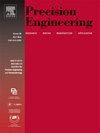Investigation into high-shear and low-pressure grinding heat using liquid-body-armor-like wheel: Theory and modeling
IF 3.5
2区 工程技术
Q2 ENGINEERING, MANUFACTURING
Precision Engineering-Journal of the International Societies for Precision Engineering and Nanotechnology
Pub Date : 2025-01-20
DOI:10.1016/j.precisioneng.2025.01.005
引用次数: 0
Abstract
High-shear and low-pressure grinding with the liquid-body-armor-like wheel has significant advantages, such as good machining quality, high adaptability, and low cost. It has a considerable potential for application in the field of precision machining. A theoretical analytical model was proposed to understand the heat dissipation mechanism and the distribution of the heat source in the high-shear and low-pressure grinding with liquid-body-armor-like wheel. Firstly, the convective heat transfer coefficient of the cutting film at the interface of the workpiece surface and wheel was solved through combining the fluid dynamic and the heat transfer. Then, a heat source model for the high-shear and low-pressure grinding was established. The temperature field under three different shapes (i.e. rectangular, triangular, and trapezoidal) of the heat source distribution were solved. Additionally, the effects of grinding velocity, workpiece feed rate, and normal grinding force on the shape of the heat source distribution were analyzed. Finally, the grinding temperature during the grinding process was measured using the thermocouple on the experimental platform to verify the model. The findings show the trapezoidal distribution of heat sources has the minimum error as compared with the rectangular and triangular heat source distribution. The theoretical analytical results and finite element simulation results agreed well with the measured temperature values. The average error of the analytical results was 5.5 %. The theoretical temperature increased with the grinding velocity and the normal grinding force. It decreased with the increase in the workpiece feed rate. The highest measured temperature was only 91.68 °C at the grinding velocity of 14 m/s in this work. The temperature was significantly lower than that of the conventional grinding. This study provides theoretical guidance for the thermal behaviors and heat generation mechanisms in high-shear and low-pressure grinding processes.
液体甲轮高剪切低压磨削热的研究:理论与建模
采用液体装甲式砂轮进行高剪切、低压磨削具有加工质量好、适应性强、成本低等显著优点。在精密加工领域具有相当大的应用潜力。提出了一种理论分析模型,以理解液身甲型砂轮高剪切低压磨削的散热机理和热源分布。首先,将流体力学与传热学相结合,求解了切削膜在工件表面与砂轮界面处的对流换热系数;然后,建立了高剪切低压磨削的热源模型。求解了三种不同热源分布形状(矩形、三角形和梯形)下的温度场。此外,还分析了磨削速度、工件进给速度和法向磨削力对热源分布形状的影响。最后,利用实验平台上的热电偶测量了磨削过程中的磨削温度,对模型进行了验证。结果表明:热源的梯形分布与矩形和三角形分布相比,误差最小;理论分析结果和有限元模拟结果与实测温度值吻合较好。分析结果的平均误差为5.5%。理论温度随磨削速度和法向磨削力的增大而增大。随着工件进给速度的增加,它逐渐减小。在磨削速度为14 m/s时,测得的最高温度仅为91.68℃。磨削温度明显低于常规磨削温度。该研究为高剪切低压磨削过程的热行为和产热机理提供了理论指导。
本文章由计算机程序翻译,如有差异,请以英文原文为准。
求助全文
约1分钟内获得全文
求助全文
来源期刊
CiteScore
7.40
自引率
5.60%
发文量
177
审稿时长
46 days
期刊介绍:
Precision Engineering - Journal of the International Societies for Precision Engineering and Nanotechnology is devoted to the multidisciplinary study and practice of high accuracy engineering, metrology, and manufacturing. The journal takes an integrated approach to all subjects related to research, design, manufacture, performance validation, and application of high precision machines, instruments, and components, including fundamental and applied research and development in manufacturing processes, fabrication technology, and advanced measurement science. The scope includes precision-engineered systems and supporting metrology over the full range of length scales, from atom-based nanotechnology and advanced lithographic technology to large-scale systems, including optical and radio telescopes and macrometrology.

 求助内容:
求助内容: 应助结果提醒方式:
应助结果提醒方式:


